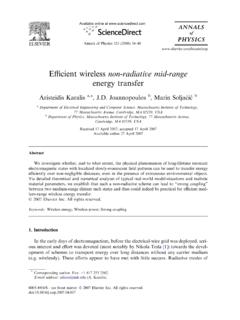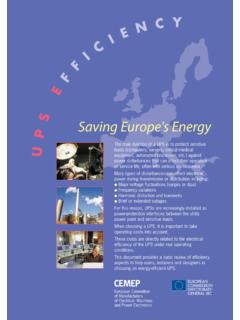Transcription of Energy systems modeling for twenty-first century …
1 Energy systems modeling for twenty - first century Energy challengesStefan Pfenninger1,*Adam Hawkes2 James Keirstead18 January 2014 (author version of accepted paper)*Corresponding author: of Civil and Environmental Engineering, Imperial College London2 Centre for Environmental Policy, Imperial College LondonPublished version:Renewable and Sustainable Energy Reviews,33, pp. : systems models are important methods used to generate a range of insight and analysis on the supplyand demand of Energy . Developed over the second half of the twentieth century , they are now seeing increasedrelevance in the face of stringent climate policy, Energy security and economic development concerns, and increasingchallenges due to the changing nature of the twenty - first century Energy system.
2 In this paper, we look particularlyat models relevant to national and international Energy policy, grouping them into four categories: Energy systemsoptimization models, Energy systems simulation models, power systems and electricity market models, and qualitativeand mixed-methods scenarios. We examine four challenges they face and the efforts being taken to address them: (1)resolving time and space, (2) balancing uncertainty and transparency, (3) addressing the growing complexity of theenergy system, and (4) integrating human behavior and social risks and opportunities. In discussing these challenges,we present possible avenues for future research and make recommendations to ensure the continued relevance forenergy systems models as important sources of information for : Energy systems modeling ; Energy policy1 IntroductionHamming(1962) argued that the purpose of computing is insight, not numbers.
3 The development of Energy systemsmodels is clearly linked to this need for insight, and the discussion on using them not just for numbers is as old as themodels themselves ( ,Huntington et al., 1982). Energy policy as a distinct field began in earnest in the wake of theoil crisis in the seventies, when both industry and policymakers realized the importance of long-term strategic energyplanning (Helm, 2002). In order to formally represent the complexity of interactions and multiple layers of Energy across amodern economy, the methods of linear programming in use for large-scale planning since the second world war wereused to develop the first Energy systems models (Dantzig, 1965). The International Energy Agency (IEA) was founded in11974, and its Energy Technology systems Analysis Program (ETSAP), intended to develop an Energy systems model,was launched in 1976.
4 The International Institute for Applied systems Analysis (IIASA), founded in 1972 as a center forscientific collaboration between east and west, also began efforts to develop an Energy systems model soon after itsfounding. Both of these models remain important today. Although initially developed for use primarily in the EIA membercountries and other large developed economies, these and later models have since been used for analysis in a wide rangeof contexts ranging from small off-grid systems in developing countries ( et al., 2011; Ghosh et al., 2002; Wrightet al. , 2010) to large-scale continent-wide analyses in developed economies ( , 2012; Gracceva and Zeniewski,2013).The development of Energy systems models can also be linked to the rising importance of scenario planning throughoutthe twentieth century .
5 According toChermack et al.(2001), after being pioneered at the RAND Corporation in the 1940s as future-now thinking , an increasing focus on scenario planning was again one of the lessons learned from the oil crisis inthe seventies. Energy systems models helped analysts understand a sector that had grown increasingly complex, and todevelop scenarios about its possible future evolution. But Energy systems models did not just allow for the developmentof scenarios, they also made possible the formalization of scattered knowledge about the complex interactions in theenergy sector, and a structured way of thinking about the implications of changes to parts of the system. Most importantly,they allowed policy-makers to explicitly state their views on the direction the Energy sector should be steered towards inorder to fulfill given policy is closely linked to a confluence of key problems and opportunities, and in the twenty - first century this is driving arenewed effort to improve the model-based analysis of Energy systems .
6 The challenges include security, affordabilityand resilience of Energy supply, as well as environmental concerns, ranging from local air and water pollution to, mostimportantly, climate change and global sustainability. But there are also opportunities: bringing new technologies tomarket, building competitive new industries, and providing vast new sustainable Energy production to those parts of theworld experiencing rapid economic Energy systems models were initially focused more on Energy security and costs, climate change policy has sinceemerged as a powerful factor driving many studies, with a focus on pathways to achieve the significant reductionsin greenhouse gas emissions called for by climate science (Meinshausen et al.)
7 , 2009). Such mitigation scenarios arepresented at a global scale for instance in the Global Energy Assessment (GEA, 2012), at a European scale inSchellekenset al.(2011), and at a United Kingdom scale inMacKay(2009) or Committee On Climate Change(2011). Because someend-use sectors (such as air transport) are difficult to decarbonize using available technology, a common theme in thesestudies is the need to achieve deep emissions reductions in the electricity sector, and an increase in electricity productionto electrify ground transportation as well as heating and cooling. Renewable Energy sources, particularly wind and solarpower, play a critical role in these low-carbon electricity this context, the established methods to model Energy systems at a national and international scale are being challengedby several emerging issues: (1) the rise of flexible demand driven by new technologies such as smart meters and distributedgeneration, (2) the importance of electrification and intermittent supply, with the resulting need for more temporal detail,and (3) the new paradigm of distributed Energy and varying renewable resource potential with the resulting need for morespatial detail.
8 None of these issues were of concern for twentieth- century Energy systems based primarily on large-scalecentralized electricity production and fossil example, questions about the viability of renewable Energy are widely debated. While one study may suggest highcosts due to intermittency without adequate storage (Gross et al., 2006), others show that close to 100% percent of powersupply can be met by renewables at feasible costs (Budischak et al., 2013). A traditional Energy systems model is unableto assess such competing claims, yet now that a transition to a renewable Energy system is under serious consideration,such questions become important. Scenarios produced by the large Energy systems models can produce aggregate costfigures and decarbonization targets, and can thus reiterate and refine the argument for decarbonization, but they cannotanswer questions about feasible configurations of a real renewables-based Energy system or the possible roadblocksthat stand in its way (UKERC, 2013).
9 Thus, recent modeling efforts are attempting to deliver the necessary spatial andtemporal resolution that can help answer these questions (Haller et al., 2012b; Pfluger and Wietschel, 2012; Fripp, 2012).In this paper we examine how Energy systems modeling is changing to address these challenges, and describe both howexisting and well-established models are adapting and the types of new models that are emerging. To do so, we identifyand discuss four key groups of Energy systems models with an important role in underpinning national and internationalenergy policy in Section3. This highlights four important challenges which are discussed in Section4, and we examinethe efforts taken to address them. Finally, in Section5, we examine the implications of our review for Energy systemsmodeling and Energy MethodWe define an Energy system as the process chain (or a subset of it) from the extraction of primary Energy to the useof final Energy to supply services and goods ( , the definition given inGEA, 2012).
10 In other words, an Energy systemencompasses the combined processes of acquiring and using Energy in a given society or economy (Jaccard, 2005).The building blocks of a model to depict such a system can thus include technical, environmental and even socialelements, but most models focus on the former two. The Energy modeling landscape is vast, but we are here interestedin models that look at the systems aspect and the interaction between the Energy system and the wider economy. Wetherefore exclude models and methods that deal with only one specific subset of problems, such as quantifying thepotential for a specific our review, we draw on several recent analyses of Energy systems models with different emphases (see Table 1).There are two recent broad overviews of Energy models,Jebaraj and Iniyan(2006), which contains a listing of modelspublished up to 2005, ranging from demand-focused models through planning, policy, and operation models, andBazmiand Zahedi(2011), who focus on power sector and optimization models in particular, looking at models ranging from plantoperation, power distribution, consumption in residential and industrial buildings, through to larger-scale systems modelsfor policy and planning.


